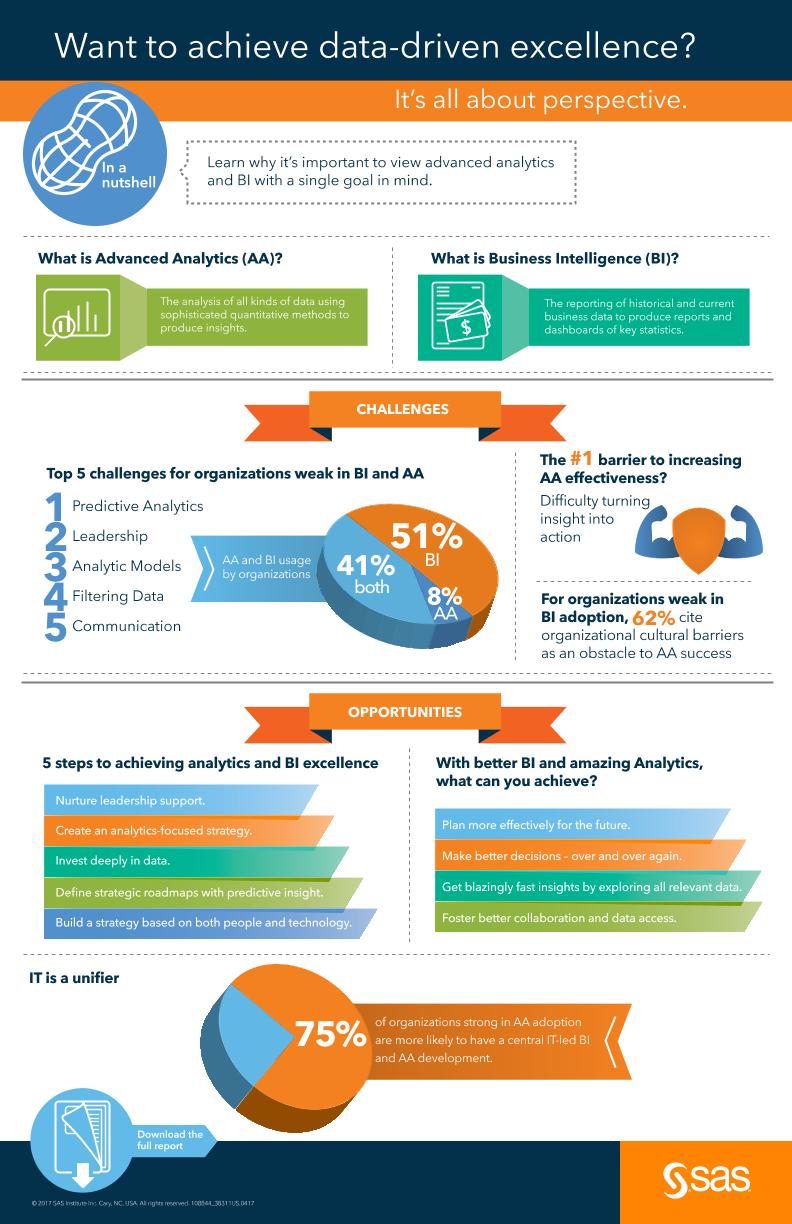IIA research identifies barriers to business intelligence and analytics adoption
By Tapan Patel, Principal Product Marketing Manager, SAS
What’s the best way to make sound business decisions? Look back to what happened in the past? Or try to predict the future? Increasingly, organizations believe it’s not a matter of picking one or the other. The challenge is finding the tools that enable both a business intelligence (BI) and analytics strategy.
Because of this, organizations are adopting business intelligence and advanced analytics in a complementary manner to achieve bigger gains. For those looking to bolster both existing BI and analytics programs, a natural way to start is by pinpointing key areas for improvement.
The biggest gaps include:
- Data preparation – Can you perform data management tasks to aggregate and cleanse data prior to reporting and analytics?
- Skills and leadership – Do you have a management structure attuned to the needs of both basic BI and analytics needs as well as more advanced analytics methods?
- Ease of use – Can less technical users can apply business intelligence and analytics technologies more broadly across the organization?
Gap 1: Data preparation
The report found that the biggest gaps lie in the area of data prep. Even organizations that take advantage of BI and data exploration see gaps in their ability to filter, transform and prepare data. Having good data is essential for quickly identifying relationships and potential outcomes to improve productivity. Automation and adding self-service aspects to data preparation workflow will help meet the needs of nontechnical users.
Not surprisingly, effective implementation of data-related activities for advanced analytics lags behind BI. When it comes to advanced analytics, the report showed that organizations need to improve their ability to prepare, augment and explore data to identify root causes or trends and build and update predictive models using machine learning. Organizations that value the ability to parse and analyze unstructured data using text analytics also recognize opportunities to improve.
Gap 2: Skills and leadership
While data preparation capabilities are critical to BI and advanced analytics adoption, the “softer” areas of culture, leadership and skills are also key. Even organizations that are strong in these areas say that they see significant challenges with things like innovation, creativity and leadership. As the report reveals, weak adopters of both BI and advanced analytics should see opportunities for executive support. Without a strong vision and buy-in at the executive level, resulting initiatives will naturally fail or underperform. To improve adoption, leaders need to openly demonstrate and quantify the value or metrics of success from these initiatives.
As organizations pursue the path from BI to an advanced analytics continuum, the skills and competencies required from data scientists are broader than those of BI/reporting staff or business analysts. Finding and retaining data scientists with multidisciplinary skills can be difficult, and organizations will have to overcome this barrier to get value from data-driven decision making.
Gap 3: Self-service BI and analytics for nontechnical users
Data analysts and data scientists can be hard to find, and the ones you do have are often overworked. Ultimately, organizations that want to gain the most benefit from BI and analytics need to put self-service and interactive tools into the hands of more nontechnical users. To accomplish this, BI and analytics software will need to become smarter and automated to improve the efficiency and productivity.
In the future, organizations will be looking to implement capabilities that automatically:
- Detect relationships, correlations, segments and outliers in the data.
- Present a context-based narrative of the most important findings in the data.
- Explore data via natural language query technologies. Leverage graph analysis to relate entities and visualize important relationships.
- Profile data, identify attributes, and infer metadata.
- Perform intelligent joins and generate hierarchies.
How to increase adoption of BI and analytics in your organization
Based on these results, IIA offers several recommendations for organizations looking to beef up their BI and advanced analytics capabilities, including:
- Invest in data and data preparation. Without addressing the challenges associated with preparing data, it will be difficult to unlock broader value from BI and analytics. Analytical speed and agility are of no use if you’re stuck with manual and inefficient data preparation steps and processes.
- Nurture culture, skills and leadership. The commonly expressed barriers of lacking strong leadership and limited talent acquisitions are clearly essential to bolstering a BI and analytics program. This key finding cannot be overstated.
- Keep self-service and ease of use front and center. As more users across organizations become increasingly interested in joining and exploring data, visualizing relationships in data and creating context-based narratives on their own, ease of use and smart/automated capabilities are imperative to helping boost the adoption of BI and advanced analytics. The trick, of course, will be delivering these features in a governed, consistent manner!
Tapan Patel is principal product marketing manager at SAS. With more than 15 years in the enterprise software market, he leads global marketing efforts at SAS for business intelligence, predictive analytics and in-memory analytics. He works closely with customers, analysts, press and and thought leaders to ensure that SAS continues to deliver high-value solutions. As a content marketer and speaker, Tapan specializes in topics related to visual data discovery, self-service BI & analytics and data-driven decisions. Prior to SAS, Tapan worked with OpenText and Claris Lifesciences Ltd. in product management, market research and technology strategy roles.
Read More
- Find out what the next-generation of BI can do for your organization and get tips for creating a successful strategy.
- Learn about SAS BI and Analytics solutions.
Get More Insights
Want more Insights from SAS? Subscribe to our Insights newsletter. Or check back often to get more insights on the topics you care about, including analytics, big data, data management, marketing, risk and fraud.

